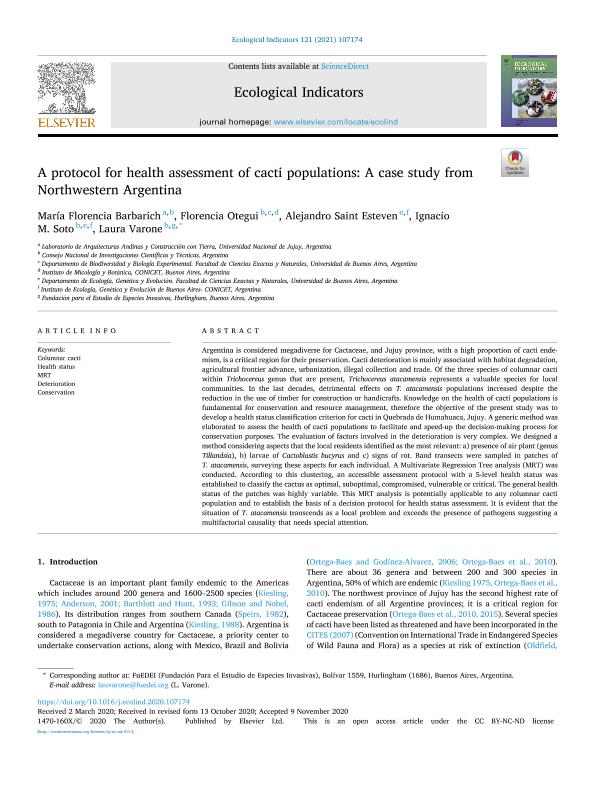Artículo
A protocol for health assessment of cacti populations: A case study from Northwestern Argentina
Barbarich, María Florencia ; Otegui, Florencia Soledad
; Otegui, Florencia Soledad ; Saint Esteven, Alejandro; Soto, Ignacio Maria
; Saint Esteven, Alejandro; Soto, Ignacio Maria ; Varone, Laura
; Varone, Laura
 ; Otegui, Florencia Soledad
; Otegui, Florencia Soledad ; Saint Esteven, Alejandro; Soto, Ignacio Maria
; Saint Esteven, Alejandro; Soto, Ignacio Maria ; Varone, Laura
; Varone, Laura
Fecha de publicación:
02/2021
Editorial:
Elsevier Science
Revista:
Ecological Indicators
ISSN:
1470-160X
Idioma:
Inglés
Tipo de recurso:
Artículo publicado
Clasificación temática:
Resumen
Argentina is considered megadiverse for Cactaceae, and Jujuy province, with a high proportion of cacti endemism, is a critical region for their preservation. Cacti deterioration is mainly associated with habitat degradation, agricultural frontier advance, urbanization, illegal collection and trade. Of the three species of columnar cacti within Trichocereus genus that are present, Trichocereus atacamensis represents a valuable species for local communities. In the last decades, detrimental effects on T. atacamensis populations increased despite the reduction in the use of timber for construction or handicrafts. Knowledge on the health of cacti populations is fundamental for conservation and resource management, therefore the objective of the present study was to develop a health status classification criterion for cacti in Quebrada de Humahuaca, Jujuy. A generic method was elaborated to assess the health of cacti populations to facilitate and speed-up the decision-making process for conservation purposes. The evaluation of factors involved in the deterioration is very complex. We designed a method considering aspects that the local residents identified as the most relevant: a) presence of air plant (genus Tillandsia), b) larvae of Cactoblastis bucyrus and c) signs of rot. Band transects were sampled in patches of T. atacamensis, surveying these aspects for each individual. A Multivariate Regression Tree analysis (MRT) was conducted. According to this clustering, an accessible assessment protocol with a 5-level health status was established to classify the cactus as optimal, suboptimal, compromised, vulnerable or critical. The general health status of the patches was highly variable. This MRT analysis is potentially applicable to any columnar cacti population and to establish the basis of a decision protocol for health status assessment. It is evident that the situation of T. atacamensis transcends as a local problem and exceeds the presence of pathogens suggesting a multifactorial causality that needs special attention.
Palabras clave:
COLUMNAR CACTI
,
CONSERVATION
,
DETERIORATION
,
HEALTH STATUS
,
MRT
Archivos asociados
Licencia
Identificadores
Colecciones
Articulos(CCT - SALTA-JUJUY)
Articulos de CTRO.CIENTIFICO TECNOL.CONICET - SALTA-JUJUY
Articulos de CTRO.CIENTIFICO TECNOL.CONICET - SALTA-JUJUY
Articulos(IEGEBA)
Articulos de INSTITUTO DE ECOLOGIA, GENETICA Y EVOLUCION DE BS. AS
Articulos de INSTITUTO DE ECOLOGIA, GENETICA Y EVOLUCION DE BS. AS
Articulos(INMIBO (EX - PROPLAME))
Articulos de INSTITUTO DE MICOLOGIA Y BOTANICA
Articulos de INSTITUTO DE MICOLOGIA Y BOTANICA
Articulos(SEDE CENTRAL)
Articulos de SEDE CENTRAL
Articulos de SEDE CENTRAL
Citación
Barbarich, María Florencia; Otegui, Florencia Soledad; Saint Esteven, Alejandro; Soto, Ignacio Maria; Varone, Laura; A protocol for health assessment of cacti populations: A case study from Northwestern Argentina; Elsevier Science; Ecological Indicators; 121; 2-2021; 1-8
Compartir
Altmétricas



